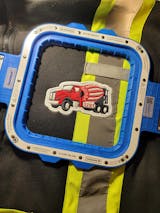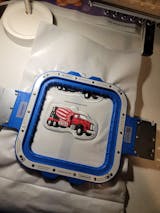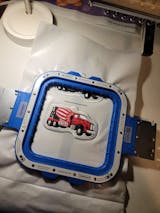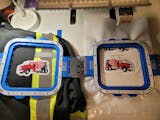1. Introduction to Rhinestone Embroidery
Rhinestone embroidery is where classic craftsmanship meets contemporary sparkle—a marriage of thread and crystal that transforms ordinary fabric into dazzling, personalized art. From high-fashion jackets and statement tote bags to custom dancewear and chic accessories, the allure of rhinestone embroidery lies in its ability to catch the eye and ignite the imagination. Whether you’re a seasoned embroiderer or a curious beginner, the world of rhinestone embellishment offers endless creative possibilities.
This guide will walk you through the essential techniques for applying rhinestones, the must-have tools and equipment, and practical tips for ensuring your designs stand the test of time. We’ll also explore business opportunities, advanced design strategies, and the evolving landscape of rhinestone application—so you can confidently add bling to your creations or even launch your own “bling business.” Ready to discover the secrets behind those show-stopping, sparkling designs? Let’s dive in.
Table of Contents
- 1. Introduction to Rhinestone Embroidery
- 2. Step-by-Step Rhinestone Application Techniques
- 3. Essential Tools and Equipment Breakdown
- 4. Durability, Care, and Troubleshooting
- 5. Building a Rhinestone Embroidery Business
- 6. Material Selection and Budget Alternatives
- 7. Advanced Techniques: Combining Rhinestones with Embroidery
- 8. Conclusion: Mastering the Craft
- 9. Frequently Asked Questions
2. Step-by-Step Rhinestone Application Techniques
Rhinestone embroidery isn’t just about sticking gems onto fabric—it’s a precise process that blends artistry, technique, and the right tools. Below, we break down the most effective methods, drawing from expert tutorials, research, and real-world project guides.
2.1 Template-Based Application System
The template-based system is the backbone of professional rhinestone application, offering both precision and repeatability. Here’s how the magic happens:
1. Design and Template Creation
Begin by cutting your desired pattern into a sheet of rhinestone template material—typically a flocked, velvety surface that holds stones in place. Use a digital cutter like Cricut Joy or Silhouette for intricate designs, or cut by hand for simpler motifs. Place the template flock-side up on a cutting mat and remove the protective backing to reveal the cutouts.
2. Stone Placement
Pour rhinestones over the template. Using a rhinestone brush, gently sweep the stones in circular motions so they nestle right-side-up into the holes. Excess stones are brushed away, leaving only perfectly positioned gems.
3. Transfer Tape Application
Cut a piece of rhinestone transfer tape (sometimes called KTM mask) to size and press it over the arranged stones. Use your fingers or a brayer to ensure firm adhesion, then carefully peel back the tape—lifting the entire design in one sparkling sheet.
4. Positioning and Heat Pressing
Lay your fabric flat, prepping it by removing moisture with a quick pre-press if needed. Place a foam board inside items like tote bags or jackets to create a firm, even surface. Align your rhinestone transfer on the fabric, cover with a protective layer (such as a Teflon sheet if needed), and apply heat—typically at 320–350°F for 12–25 seconds with medium pressure. The heat activates the adhesive, bonding the stones securely.
5. Finishing Touches
Let the design cool, then gently peel away the transfer tape. If any stones didn’t stick, simply reapply heat or press them individually with a hotfix tool.
This method ensures crisp, consistent designs—perfect for monograms, logos, and multi-deck motifs. As shown in YouTube tutorials, it’s especially effective for complex projects like tote bags and varsity jackets, where even pressure and precise placement are crucial.
2.2 Hotfix Technology for Secure Adhesion
Hotfix rhinestones are game-changers. Each stone comes with heat-activated adhesive on its back, eliminating the need for messy glues. Here’s why hotfix technology is a favorite among pros and DIYers alike:
- Precision Placement: Hotfix applicators—like the Worthofbest Hotfix Rhinestone Setter or GoldStar Tool Hot-Fix Setter—allow you to pick up individual stones and apply them exactly where you want. Interchangeable tips accommodate sizes from 2mm to 9mm, making it easy to switch between different rhinestone types.
- Durability: The adhesive forms a strong molecular bond with fabric fibers, ensuring stones stay put through washing and regular wear.
- Efficiency: No extra adhesives mean less mess and faster workflow. Applicators heat up quickly, and the process is intuitive—ideal for both beginners and experienced crafters.
- Material Compatibility: Hotfix systems work on a wide range of fabrics, including cotton, denim, synthetics, and even leather.
To use a hotfix applicator, simply load the appropriate tip, pick up a rhinestone, and hold it in place on the fabric for 10–15 seconds. Let it cool for about 30 seconds before moving the item.
2.3 Visual Guide for Specific Projects: Tote Bags & Jackets
Applying rhinestones to items like tote bags and jackets introduces unique challenges—thicker materials, seams, and the need for even pressure. Here’s how to ace these projects, drawing on insights from top YouTube tutorials:
- Substrate Preparation: For tote bags, pull out any interior pockets and insert a foam board to create a flat, stable surface. For jackets, use a cutaway stabilizer and ensure the fabric is taut in the hoop.
- Template and Stone Application: Follow the template-based method to arrange your rhinestones. For multi-media designs, carefully size all parts so embroidered elements and rhinestone outlines fit together seamlessly.
- Heat Pressing: Adjust your heat press to 320–350°F and press for 12–25 seconds, depending on material thickness. Use a protective sheet if any embroidery is exposed, or rely on the hotfix tape as a barrier.
- Troubleshooting: If stones don’t adhere, check for uneven pressure or insufficient heat. Re-press as needed, especially on thick or multi-layered fabrics.
These techniques ensure your finished items are not only eye-catching but also durable—ready to become bestsellers in your shop or standout pieces in your wardrobe.
3. Essential Tools and Equipment Breakdown
Behind every stunning rhinestone embroidery project is a toolkit designed for precision, efficiency, and versatility. Let’s break down the essentials, from entry-level gadgets to industrial powerhouses.
3.1 Manual Hot-Fix Applicators and Kits
Manual hot-fix applicators are the entry point for most crafters and small businesses. Popular models like the GoldStar Setter and RNK battery-powered kits come equipped with multiple tip sizes (2mm–9mm), ensuring compatibility with a wide range of rhinestones. Here’s what sets them apart:
- Versatility: Suitable for materials like leather, denim, synthetics, cotton, and more.
- Portability: Lightweight and easy to handle—perfect for on-the-go projects or workshops with limited space.
- Precision: Interchangeable tips and integrated lighting (on some models) make it easy to place stones exactly where you want.
- Temperature Protocols: Most applicators operate at temperatures suitable for activating hotfix adhesives (typically 320–350°F), with application times of 10–15 seconds per stone.
Kits often include wax pickers, tweezers, and storage compartments for rhinestones—streamlining your workflow and keeping supplies organized.
3.2 Commercial Machines for Production Work
For those scaling up—think custom apparel shops or bling businesses—commercial rhinestone machines offer automation and speed. Standouts include:
- CAMS 1V6P Automatic Rhinestone Setting Machine: Features multi-head design and multiple color feeders, enabling complex, multi-color designs with rapid transitions. Hydraulic placement ensures precise, repeatable results.
- Spangle Elite Machine: Specializes in metallic embellishments, using punch-out mechanisms for spangle tape. While limited to single color and size at a time, it’s easy to change reels for more variety.
- Ioline CrystalPress: Compact yet powerful, integrates with most design software and offers professional-grade results without the footprint or cost of industrial systems.
These machines are ideal for high-volume production, offering software integration, consistent quality, and the ability to tackle intricate patterns at scale.
3.3 Supporting Accessories: Templates, Tweezers, Transfer Systems
No rhinestone setup is complete without the right supporting tools:
- Flock Templates: Essential for the template-based method, flock sheets (typically 12" x 15") are reusable and provide a velvety surface for easy stone placement.
- Precision Tweezers and Wax Pickers: For placing or adjusting individual stones, especially in tight or complex designs. Curved or hollow-point tweezers offer maximum control.
- Transfer Tape/Mask: Slightly tacky sheets that lift entire rhinestone arrangements from the template to the fabric.
- Brayers and Squeegees: Help secure stones to transfer tape, ensuring every gem is picked up cleanly.
- Foam Boards and Protective Layers: Create even pressure during heat pressing and protect both fabric and rhinestones from direct heat.
Quality control is key—test your setup with durability checks and ensure all stones are firmly adhered before finishing your project.
Ready to bring your embroidery to life with a touch of sparkle? With the right techniques and tools, you’re just steps away from creating professional-grade rhinestone masterpieces—whether for fun, fashion, or a flourishing business.
4. Durability, Care, and Troubleshooting
When it comes to rhinestone embroidery, nothing dulls the sparkle faster than a loose stone or a faded design. Ensuring your creations withstand the test of time—and the washing machine—requires a blend of science, care, and a dash of troubleshooting know-how. Let’s break down the essentials for keeping your bling brilliant and securely attached.
4.1 Washing Protocols and Material Compatibility
Rhinestone embroidery’s longevity hinges on understanding both the adhesive’s chemistry and the fabric’s temperament. The golden rule? Cold water is your best friend. Washing rhinestone-embellished garments in cold water (not exceeding 30°C) preserves the adhesive’s integrity, preventing premature detachment or clouding. Hand washing reigns supreme: soak your item in lukewarm water with a gentle detergent for just a few minutes, then use a soft cloth or baby toothbrush for spot cleaning. Avoid aggressive scrubbing—think of it as giving your rhinestones a spa day, not a boot camp.
If hand washing isn’t practical, opt for a gentle machine wash cycle. Always turn garments inside out and wash with similar colors. Steer clear of bleach, fabric softeners, and harsh detergents—these chemicals are notorious for breaking down adhesives and dulling that signature sparkle.
Drying matters, too. Air drying is the only recommended method. Lay garments flat to avoid gravity pulling on wet fabric and stressing the adhesive. Machine drying? Only for a quick fluff—five minutes max—after air drying, and even then, it’s a compromise. Hot cars, direct sunlight, or any high-heat environment are a no-go, as they can melt adhesives and weaken bonds over time.
Material compatibility is crucial. Natural fibers like cotton generally offer better adhesion than synthetics with water-repellent finishes. Always start with a clean, dry, and smooth surface; even microscopic residues from manufacturing can sabotage your rhinestone’s staying power. For best results, avoid fabrics with special coatings or finishes that might repel the adhesive.
4.2 Preventing Detachment and Alignment Errors
Even with meticulous care, issues can arise—think of them as rhinestone embroidery’s version of plot twists. The most common culprit behind stone detachment? Insufficient heat, pressure, or application time during initial bonding. If your rhinestones are popping off after a wash, revisit your application technique. The adhesive should bubble slightly during heat pressing, signaling a secure bond.
Surface preparation is non-negotiable. Oils, dust, or stray fibers can all interfere with adhesion. A quick wipe with rubbing alcohol or a lint-free cloth before application can make a world of difference.
For repairs, Gem-Tac glue is a go-to solution. Apply a small amount to both the stone and the fabric, press firmly for at least 10 seconds, and allow to cure fully before wearing or washing. When re-pressing, use a low-temperature iron with a protective sheet, and always test on a fabric scrap first to avoid heat damage.
Alignment errors—those pesky off-kilter designs—are often the result of hasty placement or uneven pressure. Template-based positioning systems and precision tools like wax pickers and tweezers offer the accuracy needed for professional results. If you’re integrating rhinestones with embroidery, use the correct needle (75/11 for most jobs) and avoid dense stitch patterns that can stress the thread.
Pro tip: For stretch fabrics, keep the material slightly taut during application to prevent puckering once it relaxes. Dolly boards or foam inserts can help stabilize your work surface for more even results.
Storage and handling also play a role in long-term durability. Store your finished pieces in soft cloth pouches, away from temperature extremes and abrasive surfaces. Treat your rhinestone garments like the treasures they are—delicate, dazzling, and deserving of a little TLC.
5. Building a Rhinestone Embroidery Business
Dreaming of turning sparkle into profit? The rhinestone embroidery business is booming, especially in niche markets like cheer, dance, and custom spirit wear. Whether you’re a solo creator or planning a full-scale operation, here’s how to set up shop and shine.
5.1 Essential Equipment Investment Guide
Starting a bling business doesn’t have to drain your savings. Entry-level kits are available for as little as $45, offering all the basics—manual applicators, starter stones, and templates. These kits are perfect for testing the waters or offering embellishment services on customer-owned garments.
Ready to scale? Industrial systems like the CAMS 1V6P Rhinestone Machine and Spangle Elite take production to the next level, handling bulk orders with speed and precision. Commercial embroidery machines, such as the Avancé 1501C, add multi-needle capability for integrated embroidery and rhinestone designs. These investments open doors to lucrative markets: think performance wear, custom dance uniforms, and branded corporate apparel.
Your business model can be flexible—offer embellishment services, sell finished garments, or combine both for maximum profit. The key is matching your equipment investment to your target market and production goals.
5.2 Material Sourcing and Wholesale Strategies
Sourcing quality rhinestones and supplies is the backbone of your business. Domestic suppliers like Heat Transfer Warehouse offer a vast selection of pre-designed transfers and premium low-lead hotfix stones in sizes SS6 to SS20. For those looking to cut costs, international vendors such as Olia Rhinestones provide reliable resin rhinestones with express shipping and bulk discounts.
When buying in bulk, pay attention to size and color variety—having a range of options lets you meet diverse customer demands. Establish relationships with multiple suppliers to ensure consistent quality and competitive pricing. Don’t forget the supporting cast: template systems, transfer masks, brushes, and precision tweezers are all must-haves for a smooth workflow.
5.3 Production Efficiency with Embroidery Integration
Here’s where the magic happens: combining embroidery and rhinestones for show-stopping designs. But with great sparkle comes the need for stability—especially when working on garments that require precise hooping and minimal defects.
Sewtalent magnetic hoops are a game-changer for this workflow. Their powerful magnetic clamping system holds garments securely during both embroidery and rhinestone application, dramatically reducing setup time. In fact, switching from traditional hoops to Sewtalent magnetic hoops can cut hooping time from 3 minutes to just 30 seconds per garment. That’s a 90% time savings—imagine the impact on your bottom line during high-volume production!
Beyond speed, Sewtalent magnetic hoops help minimize defects by maintaining even tension and preventing fabric slippage. This means fewer wasted materials, more consistent results, and happier customers. Whether you’re running a solo studio or a bustling shop, investing in the right hooping system can transform your business efficiency and profitability.
6. Material Selection and Budget Alternatives
Not all rhinestones are created equal—and neither are the tools and materials you’ll need to bring your designs to life. Let’s demystify the options so you can sparkle on any budget.
6.1 Crystal vs. Glass vs. Resin Rhinestones
Crystal rhinestones (think Swarovski) are the gold standard, prized for their unmatched brilliance and rainbow sparkle. They’re crafted with special additives that bend light for a dazzling effect, but they come with a premium price tag.
Glass rhinestones strike a balance between sparkle and affordability. While they lack the optical magic of crystal, they still offer impressive clarity and durability—perfect for most apparel and accessory projects.
Resin (and acrylic) rhinestones are your go-to for budget-friendly bling. Made from molded plastics, they deliver decent shine and come in a wide array of colors, including trendy Aurora Borealis (AB) finishes. While they may not rival crystal in longevity or brilliance, they’re ideal for high-volume projects, children’s crafts, or designs where cost is a primary concern.
Heat sensitivity matters. Hotfix rhinestones (with pre-applied adhesive) are best for fabrics that can withstand application temperatures of 140–180°C. For heat-sensitive materials, opt for non-hotfix (flatback) stones and use a suitable glue.
Sizing decoded: The SS (Stone Size) system ranges from SS2 (tiny, for nail art) to SS48 (large, for statement pieces). SS6–SS20 are the most versatile for apparel, offering the best mix of coverage and sparkle without overwhelming the fabric.
6.2 Cost-Effective Toolkits and DIY Solutions
You don’t need to spend a fortune to get started. Here’s how to build a budget-friendly toolkit:
- Glitz Up Tool ($24.99): This vacuum-and-heat applicator makes hotfix rhinestone application a breeze—easy to learn, quick to use, and perfect for beginners.
- Basic template flock ($3.99): Affordable and reusable, flock sheets are the foundation for template-based designs.
- Precision tweezers and brushes: Hollow point tweezers ($6.95) and a basic rhinestone brush ($7.95) offer control without breaking the bank.
- DIY templates: Repurpose cardstock or leftover flock scraps for custom templates—no need for fancy equipment.
- Starter bundles: Kits like the Crystal Rhinestone Starter Bundle ($45) or DIME Designs Rhinestone Starter Kit ($46.99–$59.99) include everything you need to hit the ground running.
Pro tip: Invest in reusable template materials and buy rhinestones in bulk to maximize savings. For small-scale or practice projects, economy stones and resin options deliver plenty of sparkle for less.
By understanding the trade-offs between materials, application methods, and tool investments, you can tailor your approach to fit both your creative vision and your wallet. Whether you’re crafting a one-of-a-kind masterpiece or launching a high-volume bling business, there’s a rhinestone solution to suit your needs—and your budget.
7. Advanced Techniques: Combining Rhinestones with Embroidery
Rhinestone embroidery isn’t just about sparkle—it’s about storytelling, layering, and pushing the boundaries of what fabric can become. When you blend the precision of embroidery with the brilliance of rhinestones, you unlock a new realm of creative expression. Whether you’re aiming for subtle shimmer or a full-on bling masterpiece, mastering advanced techniques is your ticket to truly show-stopping designs.
7.1 Digital Design Integration and Scatter Patterns
The marriage of embroidery and rhinestones begins long before the first stitch or stone—it's born in the digital studio. Resources like embroidery designs com complement software like Silhouette Studio to empower creators to orchestrate intricate layouts where thread and crystal dance together in perfect harmony.
Silhouette Studio’s Advanced Features
With its advanced rhinestone options, Silhouette Studio lets you convert flat, circular shapes into realistic, scalable rhinestone patterns. The software’s intelligence shines when resizing: it automatically adjusts the rhinestone count to maintain consistent sizing, so your vision remains intact whether you’re working on a jacket back or a dainty tote.
Pattern Fills and Mock-Ups
The software offers multiple fill styles—linear fills are perfect for geometric borders, while radial fills wrap beautifully around curves and script embroidery. Want to preview your masterpiece before committing? The realistic rhinestone preview lets you test color combos, density, and placement, ensuring every detail is dialed in before you ever touch fabric.
Scatter Style Integration
For designs that refuse to be boxed in, the scatter style technique is your best friend. By deliberately varying rhinestone sizes (from SS3 to SS20) and spacing, you can create organic, flowing patterns that trace the contours of embroidery or fade gracefully into open fabric. This is the secret to ombré and sunburst effects—start dense with larger stones, then let the sparkle gently dissipate with smaller ones, echoing embroidered gradients and adding dimension.
Size Matters
The SS (Stone Size) system is your toolkit—SS6 for subtle accents, SS10 for bold outlines, SS20 for statement bling. The same heart design, for example, might require 198 stones at SS6 but only 73 at SS10. Smart scaling ensures your rhinestones enhance, not overwhelm, your embroidery.
Design in Action
In YouTube tutorials, creators demonstrate how careful digital planning—measuring templates to fit embroidered letters, for instance—ensures rhinestones nestle perfectly alongside threadwork. The result? Monograms and motifs that pop with personality and polish.
7.2 Multi-Layer Application for Dimensional Effects
Ready to add depth and drama? Multi-layer application takes your work from flat to fabulous, layering rhinestones and embroidery for a tactile, eye-catching finish.
Bounding Box Techniques
Professional results start with precision. By cutting templates with both rhinestone placement holes and cutting guides—a method known as the bounding box technique—you guarantee clean removal and perfect alignment across layers. Compound path grouping in your design software keeps scattered rhinestone placements intact during cutting, preventing chaos at the production table.
Hand-Backing for Delicate Fabrics
Working with tricky textiles like tulle? The hand-backing technique is your ally. Gently stretch the fabric during application to prevent bunching or distortion, ensuring both rhinestones and embroidery lay smooth and dimensional. This is especially vital when layering multiple textures—think embroidered lace topped with a constellation of crystals.
Tension Control with Sewtalent Hoops
Stability is everything in layered designs. Here, Sewtalent magnetic hoops shine by holding garments taut and secure throughout both embroidery and rhinestone application. Even tension means fewer puckers, flawless alignment, and a professional finish—whether you’re embellishing a varsity jacket or a custom tote.
Application Methods: Hotfix vs. Adhesive
Choose your method based on the project. Hotfix rhinestones offer speed and flexibility, bonding quickly with heat and preserving fabric drape. For intricate or delicate work, Gem-Tac glue provides superior control and a strong, clean bond—especially important for luxury fabrics like silk.
Quality Control and Visual Hierarchy
Balance is the name of the game. Avoid clustering same-size stones; instead, plan distributions that highlight embroidered details without stealing the show. Mix in specialty shapes for added interest, and always test your design digitally before committing.
From Concept to Creation
YouTube creators often show the full journey: prepping stabilizers, hooping with care, stitching out intricate monograms, and then layering on rhinestone outlines or scatter fills. The result? Designs that shimmer with complexity and craftsmanship, ready to turn heads and spark conversations.
8. Conclusion: Mastering the Craft
Mastering rhinestone embroidery is about more than just following steps—it’s about embracing experimentation, blending classic embroidery with modern sparkle, and daring to push creative boundaries. Whether you favor template-based precision, hotfix convenience, or layered multimedia effects, the techniques and insights shared here empower you to create pieces that are both durable and dazzling. Don’t be afraid to mix materials, play with digital layouts, or try new methods. The world of rhinestone embroidery is as limitless as your imagination—so go forth and let your creativity shine.
9. Frequently Asked Questions
9.1 Q: How do I remove a rhinestone that has detached or is misplaced?
A: If a rhinestone detaches or is out of place, gently heat the area with a low-temperature iron to soften the adhesive, then use tweezers to remove the stone. For reapplication, clean the area and use a hotfix tool or Gem-Tac glue to secure a new rhinestone.
9.2 Q: What heat settings should I use for delicate fabrics when applying rhinestones?
A: For delicate fabrics, lower your heat press to around 320°F and use medium pressure for 12–15 seconds. Always use a protective layer (like a Teflon sheet) and test on a fabric scrap first to prevent scorching or melting.
9.3 Q: What is the best starter size for rhinestones in embroidery projects?
A: SS10 is a versatile starter size, offering a great balance between sparkle and subtlety. For finer details, SS6 works well, while SS16 and above are ideal for bold, statement accents.
Ready to take your rhinestone embroidery to the next level? Experiment, combine, and create—your next masterpiece is just a sparkle away!







